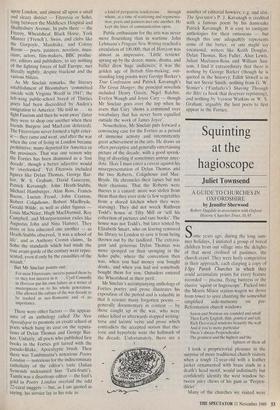Squinting at the hagioscope
Juliet Townsend
A GUIDE TO CHURCHES IN OXFORDSHIRE by Jennifer Sherwood
Robert Dugdale in association with Oxford Historic Churches Trust. £6.95
Some years ago, (hiring the long sum- mer holidays, I initiated a group of bored children from our village into the delights of that most civilised of pastimes, the church crawl. They were hotly competitive in their approach, each clasping a copy of I-Spy Parish Churches in which they could accumulate points for every feature recorded — piscina, flying buttress or the elusive 'squint or hagioscope'. Packed into the Morris Minor station-wagon we drove from tower to spire chanting the somewhat simplified aide-memoire on pre- Reformation church windows:
Saxon and Norman are rounded and small Then Early English, thin, pointed and tall, Rich Decorated windows beautify the wall And if you're more particular There's always Perpendicular, The grandest and the highest and the lightest of them all
I took a proprietorial pleasure in the surprise of more traditional church visitors when a tough 12-year-old with a leather jacket ornamented with brass studs in a death's head motif, would indistinctly but confidently identify the west window be- tween juicy chews of his gum as 'Perpen- dikler'.
Many of the churches we visited were across the county border in Oxfordshire, and I met them again with pleasure in A Guide to the Churches of Oxfordshire. Oxfordshire is a county of great geological diversity, particularly now that it has stolen from Berkshire some of the downland villages round Wantage. The grey lime- stone of the Cotswolds, the tawny iron- stone to the west of Banbury, the flint of the Chilterns give a fascinating variety to the county's churches, a variety which is meticulously documented here.
It would be wrong to think of this guide as an entirely new compilation. The author has based much of her text on her work in the Oxfordshire volume of Pevsner's Buildings of England, with additional material, especially on those villages which have more recently been incorporated into Oxfordshire. John Piper's drawings first appeared in his Shell Guide to Oxfordshire in the 1930s. Their inclusion here is parti- cularly welcome since the sad demise of the Shell series, and his picture of Adderbury church makes a splendid cover for this classy paperback.
It is a book to feed the enthusiasm rather than to kindle it, a scholarly companion in the Pevsner manner, which will tell you all you need to know about an actual building without attempting to convey the essential flavour of the place or to bring it alive as a centre of human activity. The atmosphere is realised more vividly in John Piper's drawings and photographs than in the text. The introduction leads us in a lucid and workmanlike manner through the succes- sive periods of Oxfordshire church architecture, but to bring the buildings to life I augmented it by re-reading John Betjeman's brilliant introduction to Collins Pocket Guide to English Parish Churches which brings the force of imagination to bear on the dry stones. For while this guide is a trustworthy source of information it should not be read in isolation, but in conjunction with other books less purely architectural to give the historical and anecdotal background — and also with a good map. The lack of any map in the book is extremely irritating. Even an outline of the county divided into numbered squares which could be referred to in the text would have helped. It is impossible to plan a tour of churches from the book, as there is no means of telling whether they are in neighbouring villages or at opposite ends of the county. The architectural glossary is, however, clear, concise and useful.
A guide book is like a cookery book. The only way of assessing it is by trying it out. To do so, I selected three churches at random, Islip, Iffley and St Michael's at the Northgate, Oxford, and visited them, book in hand. It became immediately clear that Jennifer Sherwood is most helpful where there is a complicated building history to unravel. Islip is a simple country church which speaks for itself. At Iffley, that splendid Norman creation of a single decade, the book was chiefly useful in
tracing the course of the various restora- tions. But at St Michael's it was invaluable in interpreting a complex history of build- ing and rebuilding, from the rough stone Saxon tower to the Victorian restoration. I certainly finished the day feeling better informed, but I would not have scored many I-Spy points. There wasn't a hagio- scope to be seen..











































































 Previous page
Previous page